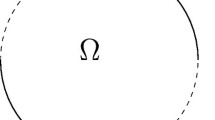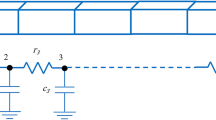Abstract
This paper aims to obtain parameters (i.e. location and dimensions) relevant to flaws in a two-dimensional body by measuring the temperature on its boundaries. In this endeavour, a steady-state heat conduction problem is formulated, and the geometry under study is subjected to a known heat load, resulting in a specific heat distribution in the body. By using a number of heat sensors, the temperature at selected points on the boundary of the body is obtained. Inverse heat conduction methods implement these temperature data, working toward estimating the flaw parameters. The objective function is optimized using conjugate gradients method, and in solving the direct problem, an FEM code is employed. To check the effectiveness of this method, sample cases with one or more circular, elliptical cavities or cracks in the body, and a case with unknown cavity shape is solved. Finally the ensuing results analyzed.
Similar content being viewed by others
Abbreviations
- f :
-
Mean squared error (target function)
- h :
-
Heat convection coefficient (Wm−2 K−1)
- k :
-
Heat conduction coefficient (Wm−1 K−1)
- l :
-
Length of crack (m)
- M :
-
Number of measurements
- N :
-
Number of unknown parameters
- q′′:
-
Heat flux (Wm−2)
- r :
-
Radius of flaw (m)
- T ∞ :
-
Surrounding temperature (K)
- x :
-
x coordinate position of flaw (m)
- y :
-
y coordinate position of flaw (m)
- \({\overline{S}}\) :
-
Vector of search direction
- \({\bar{T}}\) :
-
Vector of estimated temperatures (K)
- \({\bar{Y}}\) :
-
Vector of measured temperatures (K)
- \({\overline{\overline{D}}(.)}\) :
-
Operator to convert vector to diagonal matrix
- \({\overline{\overline{X}}}\) :
-
Matrix of sensitivity coefficients
- θ :
-
Angle of elliptical flaw by horizontal (°)
- \({\bar{\beta}}\) :
-
Vector of unknown parameters
- \({\bar{\lambda}}\) :
-
Vector of optimal step size
- (n):
-
Number of iteration
- *:
-
Optimal value
- i :
-
Sensor index
- j :
-
Unknown parameter index
- IHCP:
-
Inverse heat conduction problem
- CGM:
-
Conjugate gradient method
References
Raj B, Jayakumar T, Thavasimuthu M (2002) Practical non-destructive testing. Woodhead Publishing, Abington Hall
Cartz L (1999) Nondestructive testing: radiography, ultrasonics, liquid penetrant, magnetic particle, Eddy current. ASM International, Ohio
Afaghi Khatibi A, Maleki Rezghi H (2008) On the application of liquid–crystal thermography for the nondestructive detection of delamination in composite structure. Polym Compos 29: 798–803
Beck JV, Blackwell B, Clair SR (1985) Inverse heat conduction: ill-posed problems. Wiley, New York
Alifanov OM (1994) Inverse heat transfer problem. Springer, New York
Minkowycz WJ, Sparrow EM, Schneider GE, Pletcher RH (1988) Handbook of numerical heat transfer. Wiley, New York
Dowding KJ, Beck JV, Blackwell B (1996) Estimation of directional-dependent thermal properties in a carbon–carbon composite. Int J Heat Mass Transf 39: 3157–3164
Kim SK, Jung BS, Kim HJ, Lee WI (2003) Inverse estimation of thermophysical properties for anisotropic composite. Exp Therm Fluid Sci 27: 697–704
Hsieh CK, Kassab AJ (1986) A general method for the solution of inverse heat conduction problems with partially unknown geometries. Int J Heat Mass Transf 29(1): 47–58
Kowsary F, Siavashi M (2008) Prediction of internal flaw parameters in a two-dimensional body using steady-state surface temperature data and IHCP methods. Proc. EMS2008, 2nd UKSIM European Symposium on computer modeling and simulation (IEEE, Liverpool), pp 341–346
Comino L, Gallego R, Rus G (2008) Combining topological sensitivity and genetic algorithms for identification inverse problems in anisotropic materials. Comput Mech 41: 231–242
Tadeu A, Antonio J, Godinho L, Simoes N (2004) Boundary element method analyses of transient heat conduction in an unbounded solid layer containing inclusions. Comput Mech 34: 99–110
Lee HL, Chang WJ, Chen WL, Yang YC (2007) An inverse problem of estimating the heat source in tapered optical fibers for scanning near-field optical microscopy. Ultramicroscopy 107: 656–662
Beck JV, Arnold KL (1977) Parameter estimation in engineering and science. Wiley, New York
Tikhonov AN, Arsenin VY (1977) Solution of ill-posed problems. Winston and Sons, Washington, DC
Rao SS (1996) Engineering optimization: theory and pranctice. Wiley, New York
Partridge PW, Wrobel LC (2007) An inverse geometry problem for the localization of skin tumors by thermal analysis. Eng Anal Bound Elem 31: 803–811
Paruch M, Majchrzak E (2007) Identification of tumor region parameters using evolutionary algorithm and multiple reciprocity boundary element method. Eng Appl Artif Intel 20: 647–655
Engelhardt M, Georgios AE, Stavroulakis E, Antes H (2006) Crack and flaw identification in elastodynamics using Kalman filter techniques. Comput Mech 37: 249–265
Stavroulakis GE, Antes H (1998) Flaw identification in elastomechanics: BEM simulation with local and genetic optimization. Struct Optim 16: 162–175
Broek D (1984) Elementary engineering fracture mechanics. Martinus Nijhoff Publishers, The Hague
Author information
Authors and Affiliations
Corresponding author
Rights and permissions
About this article
Cite this article
Siavashi, M., Kowsary, F. & Abbasi-Shavazi, E. Detection of flaws in a two-dimensional body through measurement of surface temperatures and use of conjugate gradient method. Comput Mech 46, 597–607 (2010). https://doi.org/10.1007/s00466-010-0501-5
Received:
Accepted:
Published:
Issue Date:
DOI: https://doi.org/10.1007/s00466-010-0501-5




